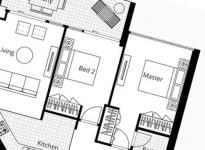How Virtual Reality Heralds Change in the Architectural Sector
With the rise of virtual reality, architectural design has changed. Architects now have more tools at their disposal than ever before.

Until fairly recently, many people didn’t have a strong opinion of Virtual Reality (VR). In fact, many thought of films like The Lawnmower Man, or failed hardware like the Nintendo Virtual Boy.
That has changed. Today, Virtual Reality is a key component of modern architecture. Oculus Rift, HTC Vive, and other hardware offer you the opportunity to showcase designs in brand new ways.
Moreover, the technology is no longer inaccessible. VR headsets and hardware are practically consumer products today. They do require investment, but you won’t spend tens of thousands of dollars to get them. Furthermore, many digital design software developers now create virtual architecture software.
It’s an exciting time, but it’s one that some architects resist. VR represents a potentially seismic shift in the industry. Naturally, there are those who would prefer sticking with what they know, rather than move forward with the technology.
You should not fall into that camp. When used correctly, virtual architecture software offers an array of business opportunities. Your firm will stand out from the crowd and build a stronger client base. Here’s how VR will bring about change in the architectural sector.
New Ways to Use Data

Traditional digital design software has its limits. You can use it to simulate real-world environments to a certain degree, but there’s only so much you can do with the data you collect.
Many architects find that virtual architecture software offers them new ways to use their data. You can start looking beyond realistic representations, towards things you can’t see. In essence, VR allows you to engage senses beyond sight.
Professionals call this immersive analytics. This is a new field that represents an evolution in data visualisation.
Think about every building you’ve designed or studied. Each one contains reams of complex data, perhaps far more than you could display with 3D modelling software. You may be able to replicate the look, but the feel is something else.
Imagine taking a building design and overlaying it with relevant environmental data. For example, you could code in data to show how the sunlight hits the building at various times of day.
With digital design software, you can see how this affects a model. Using virtual architecture software, you can feel it. The sunlight shines through windows and creates shadows, which you can explore. The data no longer just creates photo-realistic models. You can use it to simulate what it’s like to be in the model, rather than just look at it.
VR offers a more humanising experience, one that isn’t achievable with traditional software. With virtual architecture software, you can bring the conceptual to life, without losing the realism of your models. The software enhances your data, creating more convincing models in the process.
A Better Client Experience

Think about how you currently propose for a new job. You file into a conference room, set up your computer, and offer a dry description of your model. Perhaps you present all the data, and speak about your ideas. Your clients can see your models, but they rely on you to guide them through.
It’s not the most immersive experience. Clients don’t get a feel for the models you design when you talk them through. They’ll sit, listen, and nod, but they may not understand where you’re coming from. It takes a talented presenter to overcome that disconnect. Unfortunately, not everybody has the gift of the gab required.
Virtual architecture software changes how you present to your clients. Instead of expecting them to sit through a dry lecture, you can show them the buildings you create.
Immersion is the key. Your clients strap on their headsets and get taken on a journey. They can physically explore the models you create, getting a true feel for what they’d look like in real life.
This improvement in client experience doesn’t just extend to greater understanding of your models. Virtual architecture software offers your client the chance to get involved in the design process.
A client may wonder through your model, only to spot something that doesn’t seem quite right. Perhaps they don’t like how certain colours clash, or there’s a design flaw they could only spot because they’re exploring your model.
Clients can contribute to the project, without having your technical expertise. They can use what they see in the virtual world to inform their decisions. This leads to greater customer satisfaction. Hence, your clients receive more accurate representations of what they want.
The Competitive Advantage
As mentioned, virtual architecture software has met resistance from some areas of the industry. Many architects want to stick with what’s worked in the past. After all, adopting VR means learning a host of new skills. They have to get to grips with new software and figure out the hardware. Many may want to avoid the initial investment too.
All of this creates an opportunity for you. Every firm needs a unique selling point, or something that sets it apart from the competition. Virtual architecture software could be your competitive advantage.
When clients can explore a mode, and experience it on a visceral level, they gravitate towards it. You’re offering something different, something that engages them. Furthermore, they can understand the structure on their own terms. Instead of relying on you for explanations, they can see and feel your models in real time.
This sets you apart from the firm’s that don’t want to move forward. You differentiate yourself from the competition in a potential client’s eyes. You’re not one more in a sea of firms that showed off dry 2D drawings and the standard 3D models. Instead, with virtual architecture software, you offer something that captures the imagination. You engage your clients, and immerse them into the design.
Most clients won’t take too long to make a decision. Odds are, the firm using virtual reality will get the nod over all of those that don’t.
Accessibility
Let’s look at accessibility on two fronts. First, we’ll come back to the client experience. Think about how much training it took for you to understand the drawings and models you create. Your clients don’t have that same level of training. As a result, you have to explain everything about the drawings to them.
It’s an inaccessible method that alienates clients.
With virtual architecture software, you remove the barrier. Instead of spending hours talking about drawings, you can spend a few minutes explaining the VR hardware. After that, the client takes control. They access the model in ways they never thought possible. They can see how everything fits together, without needing an explanation.
That’s one side of the accessibility coin. The other side relates to an industry misconception.
Many architects see virtual architecture software and hardware as inaccessible. They assume the initial investment is so high as to make it unfeasible.
That may have been the case in the past. But today, VR is more accessible than ever.
Let’s take the Oculus Rift as an example. Headsets now cost less than $1,000 each. For an initial investment of about $10,000, you can get headsets, hardware, and virtual architecture software. Better yet, many current digital design software now incorporate virtual architecture. As a result, you don’t have to spend as much time as you may think to learn how to create virtual models.
Virtual architecture may be more accessible than you realise. The new business you can attract will often far outweigh that initial investment and learning curve.
Less Reworking of Models

Think about the traditional architectural design process. You create your 2D drawings. Then you recreate them in 3D. All the while, you’re constantly entering and re-entering data into your software.
That’s a lot of repetition from the start, and it only gets worse as you introduce your client to the model. You have to explain your models to your client, and hope they understand them. Your clients offer feedback based on what they understand. You go back and rework the model before presenting it again. The end result isn’t what your client wanted. That initial disconnect led to bad feedback, so you have to rework the model again. You repeat the process constantly until you finally deliver what the client wants.
All this stems from the client’s inability to understand your models.
Virtual architecture software bridges that gap.
Clients experience virtual reality in richer detail than they would using a 3D model. As mentioned, they can explore and get a feel for the building themselves. Once they understand the hardware, they don’t need you to talk them through it. As a result, the feedback they provide comes from a more educated place. They aren’t just guessing what they want from the building. Your clients can physically see what they like, and what they don’t.
You’ll still have to rework the model to meet your client’s requirements. However, there’s far less repetition involved in the process. The more accurate feedback means the reworking is a “once off” job.
Real-time rendering also allows you to cut down on reworking. Clients can switch lights on and off, or interact with the objects in your virtual environments. They can see how little things change the model in an instant. As a result, they don’t have to send you back to rework the model for minor changes.
Creating Real-World Scenarios
Real-world simulation extends beyond the previously mentioned lighting examples.
Imagine you’re designing a complex building, such as an airport terminal or apartment block. You build emergency exits into various points of the building, but you can’t test them with a traditional model. Instead, you have to use your experience to ensure they’re in the right place.
Virtual architecture software allows you to simulate real-world scenarios. You can use your model to test these exits. For example, you can put yourself into any location in the model, and create an emergency situation. You then explore the model to ensure you can locate emergency exits in good time. In doing so, you test the exits’ locations, and even the signage used to point people in the right direction.
That’s not all. A virtual model allows you to test how people react to such situations. Instead of assuming an optimal reaction, you can see what happens when somebody panics. You can even surround the person with a crowd to see how they’d react to a crisis situation.
As you can see, this in-depth, realistic testing has positive ramifications for building safety. You can use the insights you gather to make safer, more user-friendly structures.
Imagine any real-world scenario that may affect your building. It can be something as complex as this emergency scenario, or something as simple as seeing how easily people can pass in a hall. With virtual architecture software, you can create that scenario to see how it affects the model.
Conclusion
Virtual architecture software represents a new frontier in the architectural industry. It’s a way for you to impress clients, and help them to understand your models in brand new ways. Virtual architecture software immerses your clients in the model. They make dry presentations a thing of the past. Instead, clients can get involved and see how your models work in real-time.
This presents untold advantages to the architect. You can make changes in real-time, based on the feedback clients provide while exploring your model. As a result, you spend less time reworking models. The design process becomes more efficient, so you can turn concepts into reality in less time.
VR also offers you a competitive advantage in the current architectural industry. However, that may not last long. Despite the resistance, the technology has gained popularity. As more clients see VR in action, they’ll expect it as the norm in presentations. Adapt now and you’ll get the jump on those who wait until the last minute.
ArchiStar Academy can help. In addition to the information on the blog, ArchiStar Academy offers several courses in virtual architecture software. Furthermore, you can access this software at industry-best prices.
Contact ArchiStar Academy today to find out how we can help your firm to transition into the virtual reality era.
Please don’t hesitate to get in touch with ArchiStar Academy today if you have any questions.
If you would like to share your thoughts on our blog, we’d love to hear from you!
Get in touch with the ArchiStar Academy community via Facebook.
Posted on 20 Jan 2020
